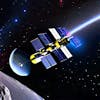S03E44: Cosmic Flares & Martian Affairs: SpaceX's Starship to the Rescue?

- Embark on an exhilarating celestial journey with today's episode of Astronomy Daily - The Podcast, where we uncover the enigmas of the universe and the latest feats in space exploration. Host Anna guides us through a cosmic tapestry woven with...
- Embark on an exhilarating celestial journey with today's episode of Astronomy Daily - The Podcast, where we uncover the enigmas of the universe and the latest feats in space exploration. Host Anna guides us through a cosmic tapestry woven with groundbreaking discoveries and thrilling space endeavors. We kick off with the James Webb Space Telescope's detection of an atmosphere on a distant rocky exoplanet, 55 Cancri e, offering a glimpse into otherworldly climates. Then, brace for a discussion on the sun's recent display of power, unleashing a trio of X-class solar flares that remind us of its fiery rule over our solar system.We celebrate the return of NASA's TESS from its unexpected hiatus, ready to resume its hunt for exoplanets. The mystery deepens with China's secretive Chang'e 6 moon mission and its mini rover passenger, poised to explore the far side of the moon. Finally, we turn our gaze to the red planet, where NASA's Mars Sample Return mission faces challenges that SpaceX's innovation might just overcome, potentially revolutionizing the timeline and cost of this interplanetary quest.1. **Webb's Exoplanet Atmosphere Discovery**: NASA's James Webb Space Telescope unveils a super Earth's atmosphere.2. **Solar Flare Fury**: The sun's recent X-class eruptions and their impact on Earth.3. **TESS's Triumphant Return**: NASA's exoplanet hunter resumes its cosmic search after a brief pause.4. **Chang'e 6's Lunar Mystery**: China's covertly added mini rover adds intrigue to lunar exploration.5. **Mars Sample Return Revolution**: How SpaceX's starship might be the game-changer for NASA's ambitious mission.Join us for a constellation of stories that illuminate our place in the cosmos, and let your imagination soar to the rhythm of the stars. Engage with our stargazing community on X (@AstroDailyPod) for continuous updates and celestial conversations. Until our next interstellar rendezvous, this is Anna reminding you to keep your eyes on the skies and your curiosity ever alight. Clear skies and boundless wonder to all our fellow space enthusiasts! This episode is presented with the support of our cosmic companions at NordPass. Secure your interstellar journey with our special offer by visiting www.bitesz.com/nordpass. Support Astronomy Daily the Podcast and access commercial-free episodes by checking out our supporter link.Become a supporter of this podcast: https://www.spreaker.com/podcast/astronomy-daily-the-podcast--5648921/support And for more Space and Astronomy News, listen to past episodes, check out sponsor links etc...just visit our website at astronomydaily.io.
AI Transcript
This podcast features the latest in astronomy discoveries and space exploration feats
Anna: Welcome to Astronomy Daily, the podcast. I'm Anna, your host, bringing you the latest in the cosmic frontier, where science fiction meets science fact. In today's episode, we'll delve into exciting astronomical discoveries and space exploration feats that are expanding our understanding of the universe. We're going to explore a realm filled with hot, rocky exoplanets and their potential atmospheres, as uncovered by NASA's James Webb space telescope. Strap in as we discuss the unpredictable nature of our sun, which has unleashed a series of powerful solar flares, reminding us of its fiery dominance in the solar system. We'll also dive into the triumphant return of NASA's transiting exoplanet survey satellite, renewed and ready to continue its quest to uncover worlds beyond our solar reach. Shifting our gaze to the moon will unravel the mystery of China's secretive Chang'e six mission, which has a mini rover hitching a ride to the far side of our lunar neighbor. Finally, we'll look ahead to the red planet itself, where NASA's Mars sample return mission faces daunting challenges. We will explore how SpaceX's innovation could be the game changer, potentially saving the mission through unorthodox but ingenious solutions. So let your curiosity lead the way as we embark on a journey through the cosmos. Keep your eyes on the stars and join us for a constellation of stories that define our place in the vast expanse of the universe. Exit Moochie for your expert, the astronomy daily podcast.
NASA's James Webb Space Telescope reveals atmosphere around distant exoplanet
In a groundbreaking discovery that's captivating astronomers worldwide, NASA's James Webb Space Telescope has presented us with the best evidence yet of an atmosphere around a rocky exoplanet far beyond the reaches of our own solar system. The subject of this revelation is 55 cancre, a, scorching super Earth, 41 light years from Earth. Lead author Ren Yew hu and his esteemed colleagues at NASA's Jet Propulsion Laboratory detail their captivating insights in the pages of nature through Webb's powerful lens. The researchers conducted meticulous observations using webbs, Nirkam, and Miri to capture infrared light from the planet. It involved a fine dance of light measurement, seeking subtle changes as the planet emerged and concealed behind its parent star. Dubbed secondary eclipse spectroscopy, this method drew a spectrum that seemed to sing with the presence of an atmosphere potentially rich in volatiles like carbon monoxide or carbon dioxide. Yet the planet itself defies simple categorization. Imagine a world so close to its star, it's likely roiling with oceans of lava, tidally locked, always presenting the same face to its sun. It's a far cry from the hospitable climates we associate with atmospheres. But here's where science pushes back the boundaries. Is it possible that this atmosphere is not a remnant of the planet's formation, but instead erupts continuously from a roiling magma ocean below? This is where the potential of Webb truly shines. We see it challenging previous observations, breaking new ground, and setting new paradigms in exoplanet research. The scientific community, including co authors Diana Dragomir and Erin Bello Aruf, glimpse in 55 cancre e not just an anomaly but a bridge to the past to probe the primordial atmospheres of rocky planets like our own Earth or our neighbors, Venus and Mars. As more secondary eclipse observations are made, astronomers wait with bated breath for the next chapter in this cosmic detective story. Webb stands as our sentinel in the stars, expanding our understanding of what conditions might sustain an atmosphere, and hence life, on rocky worlds throughout the galaxy. And amidst this universe of questions, one thing is certain. Our journey of discovery is just beginning. With 55 cancre as a beacon in the boundless night sky, the sun, akin to a celestial maestro conducting an orchestra of celestial bodies with its magnetic baton, has been steadily increasing its tempo as it marches toward the apex of its eleven year cycle of activity known as the solar maximum. In a striking showcase of solar fireworks, the sun erupted with a trio of x class solar flares within a span of just over 24 hours on the fifth and 6 May 2024. These monumental cosmic eruptions, identified as x 1.3, x one two, and a formidable x 4.5, are the most intense flares classified to date, releasing colossal bursts of energy and radiation that hold the power to significantly influence our life on Earth. Indeed, the effects of such flares ripple through our technology driven society. They bear the potential to disrupt radio communications, interfere with electric power grids on our blue planet, and pose an array of risks to sophisticated spacecraft and the intrepid astronauts within them. As we ponder the sheer magnitude of these eruptions, we're reminded of the thin veil of atmosphere that protects us from these solar tempests and the importance of understanding and predicting the behavior of our nearest star. The prediction of solar maximum events is fraught with complexities, much like trying to forecast the ebb and flow of the ocean tides without observing the moon. As with ocean tides affected by myriad gravitational factors, confirming the arrival of solar maximum can only be achieved in hindsight. Yet the scientific community, aided by agencies like NOAA's Space Weather Prediction center, persistently works to fine tune their predictive models to moderate the potentially disruptive effects of peak solar activities expected between May 2024 and early 2026. To dissect the intensity rankings of solar flares, parallels are drawn with the Richter scale used for measuring the severity of earthquakes. Each class of flares signifies a tenfold increase in energy output, with x class sitting at the pinnacle of this scale. Astronomers capture these remarkable events not simply as points of fascination but as windows into comprehending the intricate workings of our solar system's dynamo. Through the eyes of advanced solar observatories like the Solar Dynamics Observatory, the solar Orbiter, and the Parker solar probe, astronomers unveil the sun's mysteries one photon at a time. These vessels of exploration allow us to witness solar behavior from safe distances, gathering precious data that could aid in mitigating the impacts of solar turbulence while quenching our thirst for knowledge about the luminous sphere that sustains life on Earth. After a brief detour into safe mode, NASA's transiting exoplanet survey satellite, affectionately known as TESS, has resumed its celestial sweep for worlds beyond our solar system. It's a signal to astronomers and cosmologists everywhere that the hunt for exoplanets is very much back on track. On May 3, tess powered out of its protective state, sparked by an escalation in momentum within its reaction wheels, which are pivotal for the fine tuning of its gaze into the depths of space. This temporary standstill wasn't the spacecraft's first. It follows on the heels of a similar hitch earlier in April, marking a touch of unpredictability in what has been a landmark mission for NASA thus far. Despite these hiccups, Tess's six year sojourn in space has been nothing short of historic, marked by its unparalleled survey of the stars for transitory dips in brightness, a telltale sign of planets passing before them. The magnitude of its discoveries is hard to understate, with Tess having recently flagged its first rogue exoplanet, a lone wanderer without a star to call home. Revealing itself not through dimming starlight but by the subtle brightening of a background star, a phenomenon implicated by Einstein's iconic theory of general relativity. Tess's crucial role in our understanding of the cosmos continues to unfold in real time. And now, as it readies itself for its third and fourth extended missions, NASA has put a call out for scientific contributions that will sharpen its exploratory edge even further. In this grand cosmic ballet, Tess is more than just a passive observer. It's a testament to our relentless curiosity, a, spacecraft that, despite mechanical setbacks, reaffirms our place as not just stargazers, but as galaxy tappers ever in search of new frontiers, new worlds, and perhaps one day, new neighbors in this vast, ever expanding universe we call home.
China's Chang'e six lunar mission includes an unannounced rover
The Astronomy Daily podcast the moon, Earth's closest celestial companion, continues to be a hotbed of exploration and intrigue. Among the latest chapter in lunar exploration is China's Chang'e six mission. What makes this mission particularly riveting is the presence of an unannounced passenger, a, mini rover whose details were curiously kept under wraps until savvy observers spotted it attached to the lander in newly released photographs. The change six mission, launched by the China Academy of Space Technology, is tasked not only with collecting surface samples from the moon's far side, an area that remains enigmatic due to its perpetual concealment from our view, but also with returning them to Earth. This alone is a monumental endeavor, mirroring the historic Changi five's successful sample retrieval in 2020. But the twist in the plot came to light post launch with images that showcase a diminutive rover latched to the side of the lander. Its design and specific objectives haven't been disclosed, prompting speculation and curiosity within the space science community. One thing, however, is clear. The inclusion of this rover adds another layer of complexity and capability to the mission's scientific pursuits. Adding to the mystery, the Shanghai Institute of Ceramics mentioned that the rover is equipped with an infrared imaging spectrometer. The technology portends its potential in studying the lunar surface in rich, unprecedented detail. Yet given the constraints the mini rover would face within the harsh lunar environment, expectations are that its service will be brief, yet undoubtedly valuable. This isnt the first instance of Chinas clandestine approach to its space program. In the recent past, China has included undisclosed payloads and surprise maneuvers in both lunar and martian expeditions. While keeping details close to its chest, China straddles the fine line between state secrecy and the open spirit of scientific discovery that characterizes much of space exploration. As the Chang'e six mission progresses and the mini rover deploys to traverse the shadowed lunar expanses, we are reminded that the moon still has many secrets to unveil. And with each tire track printed into the lunar dust, we become witnesses to the unfolding narrative of our moon's far side, a, narrative now marked with the wheels of a rover born from shadowy Genesis.
NASA's Mars sample return mission faces daunting budget and timeline challenges
As the red planet beckons, NASA's Mars sample return mission stands on the brink of transforming our search for life beyond Earth. Confronted with a budget that has spiraled to more than $11 billion and a timeline that threatens to push the return of martian samples to 2040. The mission is at a critical juncture. These challenges have prompted NASA to eye the private sector for swifter, more cost effective strategies to bring these precious martian pieces home. Enter SpaceX. Known for its audacious approaches and disruptive innovation, SpaceX might hold the key to unlocking a more feasible path for the mission. The company has been integral in America's imminent return to the moon. With its starship rocket poised for the Artemis III mission, this very spacecraft, currently under testing, could be pivotal in a potential redesign of the Mars sample mission. Imagine a scenario where SpaceX's behemoth, the starship capable of lifting significant payloads, undertakes a mission to Mars and back. The staggering potential of this vessel is clear. It could return a trove of samples within a single two year flight. This not only allegorizes a significant cost reduction, but also a monumental leap in the expedition's timeframe. Yet embracing such a path isn't devoid of challenges. Starship's towering aspirations ride alongside its unproven efficacy and a set of risks. For one, the rocket's capability stands still in its testing phase, requiring advanced development before we assign to it the responsibility of carrying human or precious martian cargo. Moreover, the infrastructure necessary for a martian launch pad and refueling station, prerequisites for Starship's round trip, are yet foundational blueprints away from reality. With NASA's sampler rover perseverance already stockpiling scientific wealth within martian craters, it's an audacious race against time and budget. A, mission reimagined with SpaceX's starship, while brimming with vast potential, raises pivotal questions of feasibility and safety. The sensibilities of private sector innovations versus the intricacies of space bureaucracy are being laid bare in this interplanetary venture. The audacious ballet of returning to Earth with a piece of Mars is a symphony SpaceX might just be composing as the private space titan possibly paves a new trail through extraterrestrial sands. The coming weeks could disclose whether SpaceX's ingenuity will redefine our journey to an understanding of Mars as we bring our interstellar journey to a gentle landing. I'd like to extend a heartfelt thank you for joining us on today's adventure through the cosmos on Astronomy Daily, the podcast if today's stories have sparked your curiosity for the stars, I cordially invite you to delve deeper into the universe's mysteries with our dedicated team. Make your way over to astronomydaily .io to uncover even more space and astronomy news, connect with a community of fellow cosmic enthusiasts, listen to back episodes, and never miss an astronomical beat by subscribing to our daily newsletter. And for those of you stargazers yearning to keep the conversation going, follow our trail of cosmic breadcrumbs on X, formerly known as Twitter. Find us at AstroDailyPod Daily Pod and join a constellation of like minded individuals as we share, discuss, and marvel at the celestial wonders that await us. Until next time, this Anna saying keep your eyes on the skies and your hearts filled with wonder. This is astronomy daily, the podcast signing off.
New to Astronomy Daily - The Podcast?
Here are some great episodes to start with.

















